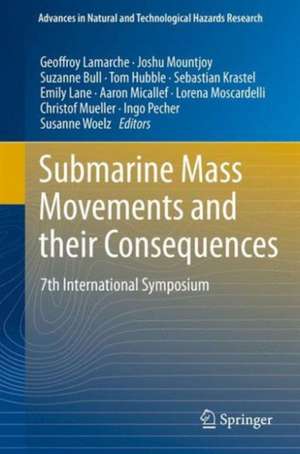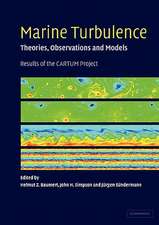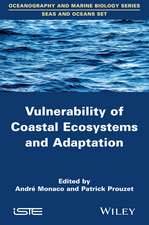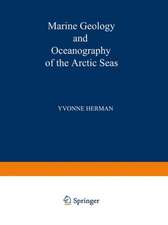Submarine Mass Movements and their Consequences: 7th International Symposium: Advances in Natural and Technological Hazards Research, cartea 41
Editat de Geoffroy Lamarche, Joshu Mountjoy, Suzanne Bull, Tom Hubble, Sebastian Krastel, Emily Lane, Aaron Micallef, Lorena Moscardelli, Christof Mueller, Ingo Pecher, Susanne Woelzen Limba Engleză Hardback – 14 oct 2015
As the world’s climate and energy needs change, the conditions under which slope instability occurs and needs to be considered, are also changing. The science and engineering of submarine – or more widely subaqueous – mass movements is greatly benefiting from advances in seafloor and sub-seafloor surveying technologies. Ultra-high-resolution seafloor mapping and 3D seismic reflection cubes are becoming commonly available datasets that are dramatically increasing our knowledge of the mechanisms and controls of subaqueous slope failure. Monitoring of slope deformation, repeat surveying and deep drilling, on the other hand, are emerging as important new techniques for understanding the temporal scales of slope instability. In essence, rapid advances in technology are being readily incorporated into scientific research and as a result, our understanding of submarine mass movements is increasing at a very fast rate. The volume also marks the beginning of the third IGCP project for the submarine mass movement research community, IGCP-640 S4SLIDE (Significance of Modern and Ancient Submarine Slope LandSLIDEs). The Submarine Mass Movements and Their Consequences symposium is the biannual meeting under the IGCP umbrella.
| Toate formatele și edițiile | Preț | Express |
|---|---|---|
| Paperback (1) | 960.42 lei 6-8 săpt. | |
| Springer International Publishing – 23 aug 2016 | 960.42 lei 6-8 săpt. | |
| Hardback (1) | 977.97 lei 3-5 săpt. | |
| Springer International Publishing – 14 oct 2015 | 977.97 lei 3-5 săpt. |
Din seria Advances in Natural and Technological Hazards Research
- 18%
 Preț: 921.15 lei
Preț: 921.15 lei - 18%
 Preț: 1406.35 lei
Preț: 1406.35 lei - 18%
 Preț: 788.72 lei
Preț: 788.72 lei - 15%
 Preț: 643.84 lei
Preț: 643.84 lei - 18%
 Preț: 955.56 lei
Preț: 955.56 lei - 18%
 Preț: 954.31 lei
Preț: 954.31 lei - 18%
 Preț: 958.56 lei
Preț: 958.56 lei - 18%
 Preț: 937.56 lei
Preț: 937.56 lei - 18%
 Preț: 952.72 lei
Preț: 952.72 lei -
 Preț: 382.18 lei
Preț: 382.18 lei - 15%
 Preț: 647.92 lei
Preț: 647.92 lei - 18%
 Preț: 948.47 lei
Preț: 948.47 lei - 15%
 Preț: 640.06 lei
Preț: 640.06 lei -
 Preț: 407.01 lei
Preț: 407.01 lei - 15%
![Submarine Mass Movements and Their Consequences [With CDROM]](https://i4.books-express.ro/bs/9781402012440/submarine-mass-movements-and-their-consequences-with-cdrom.jpg) Preț: 604.37 lei
Preț: 604.37 lei - 15%
 Preț: 643.48 lei
Preț: 643.48 lei - 15%
 Preț: 648.05 lei
Preț: 648.05 lei - 18%
 Preț: 1236.99 lei
Preț: 1236.99 lei - 18%
 Preț: 947.35 lei
Preț: 947.35 lei - 18%
 Preț: 947.35 lei
Preț: 947.35 lei - 18%
 Preț: 966.15 lei
Preț: 966.15 lei - 15%
 Preț: 642.51 lei
Preț: 642.51 lei - 18%
 Preț: 951.29 lei
Preț: 951.29 lei - 18%
 Preț: 1255.16 lei
Preț: 1255.16 lei - 15%
 Preț: 642.51 lei
Preț: 642.51 lei - 15%
 Preț: 646.43 lei
Preț: 646.43 lei - 15%
 Preț: 635.96 lei
Preț: 635.96 lei - 18%
 Preț: 1244.08 lei
Preț: 1244.08 lei
Preț: 977.97 lei
Preț vechi: 1192.64 lei
-18% Nou
Puncte Express: 1467
Preț estimativ în valută:
187.19€ • 203.40$ • 157.34£
187.19€ • 203.40$ • 157.34£
Carte disponibilă
Livrare economică 31 martie-14 aprilie
Preluare comenzi: 021 569.72.76
Specificații
ISBN-13: 9783319209784
ISBN-10: 3319209787
Pagini: 621
Ilustrații: XIII, 621 p.
Dimensiuni: 155 x 235 x 39 mm
Greutate: 1.38 kg
Ediția:1st ed. 2016
Editura: Springer International Publishing
Colecția Springer
Seria Advances in Natural and Technological Hazards Research
Locul publicării:Cham, Switzerland
ISBN-10: 3319209787
Pagini: 621
Ilustrații: XIII, 621 p.
Dimensiuni: 155 x 235 x 39 mm
Greutate: 1.38 kg
Ediția:1st ed. 2016
Editura: Springer International Publishing
Colecția Springer
Seria Advances in Natural and Technological Hazards Research
Locul publicării:Cham, Switzerland
Public țintă
ResearchCuprins
1. Submarine Mass Movements and Their Consequences: Progress and Challenges.- Part I Submarine Mass Movement in Margin Construction and Economic Significance2. The Role of Submarine Landslides in the Law of the Sea.- 3. Fabric Development and Pore-Throat Reduction in a Mass-Transport Deposit in the Jubilee Gas Field, Eastern Gulf of Mexico: Consequences for the Sealing Capacity of MTDs.- 4. Seismic geomorphology of the Israel Slump Complex in the central Levant Basin (SE Mediterranean).- 5. Multiple Megaslide Complexes and their Significance for the Miocene stratigraphic evolution of the offshore Amazon Basin.- 6. Kinematics of submarine slope failures in the deepwater Taranaki Basin, New Zealand.- Part II Failure dynamics from landslide geomorphology.- 7. Postglacial Mass Failures in the Inner Hardangerfjorden System, Western Norway.- 8. Onshore and offshore geomorphological features of the El Golfo debris avalanche (El Hierro, Canary Islands).- 9. New insights on failure and post-failure dynamics of submarine landslides on the intra-slope Palmarola ridge (Central Tyrrhenian Sea).- 10. Assessment of Canyon Wall Failure Process from Multibeam Bathymetry and Remotely Operated Vehicle (ROV) Observations, U.S. Atlantic Continental Margin.- 11. The Chuí Megaslide Complex: regional-scale submarine landslides on the Southern Brazilian Margin.- 12. Submarine landslides and incised canyons of the southeast Queensland continental margin.- 13. Novel method to map the morphology of submarine landslide headwall scarps using Remotely Operated Vehicles.- 14. Flow behaviour of a giant landslide and debris flow entering Agadir Canyon, NW Africa.- 15. Fine-Scale Morphology of Tubeworm Slump, Monterey Canyon.- 16. Submarine slide topography and the Distribution of Vulnerable Marine Ecosystems: A Case Study in the Ionian Sea (Eastern Mediterranean).- Part III Geotechnical aspects of mass movement.- 17. Shear Strength of Siliciclastic Sediments fromPassive and Active Margins (0-100 meters below seafloor): Insights into Seismic Strengthening.- 18. A small volume calibration chamber for cone penetration testing (CPT) on submarine soils.- 19. Underwater Mass Movements in Lake Mjøsa, Norway.- 20. In situ cyclic softening of marine silts by vibratory CPTU at Orkdalsfjord test site, mid Norway.- 21. First results of the geotechnical in situ investigation for soil characterisation along the upper slope off Vesterålen - Northern Norway.- 22. A novel micro-shear tester for failure analysis of fine and cohesive granular matter.- 23. Knickpoint migration induced by landslide: Evidence from laboratory to field observations in Wabush Lake.- 24. Multiple flow slide experiment in the Westerschelde Estuary, The Netherlands.- Part IV Multidisciplinary case studies.- 25. Submarine mass wasting on Hovgaard Ridge, Fram Strait, European Arctic.- 26. 3D seismic investigations of Pleistocene Mass Transport Deposits and Glacigenic Debris Flows on the North Sea Fan, NE Atlantic Margin.- 27. Do embedded volcaniclastic layers serve as potential glide planes? – An integrated analysis from the Gela Basin offshore southern Sicily.- 28. Sediment failure affecting muddy contourites on the continental slope offshore northern Norway – lessons learned and some outstanding issues.- 29. Mass Wasting History within Lake Ohrid Basin (Albania/Macedonia) over the last 600ka.- 30. Implications of Sediment Dynamics in Mass Transport along the Pianosa Ridge (Northern Tyrrhenian Sea).- 31. Late-Holocene Mass Movements in High Arctic East Lake, Melville Island (Western Canadian Arctic Archipelago).- 32. Pleistocene Mass Transport Complexes off Barbados accretionary prism (Lesser Antilles).- 33. Exploring the Influence of Deepwater Currents as Potential Triggers for Slope Instability.- Part V Tectonics and mass movements.- 34. French alpine foreland Holocene paleoseismicity revealed by coeval mass wasting deposits in glacial lakes.-35. Spatial and temporal relation of submarine landslides and faults along the Israeli continental slope, eastern Mediterranean.- 36. Earthquake induced landslides in Lake Éternité, Québec, Canada.- 37. Large Mass Transport Deposits in Kumano Basin, Nankai Trough, Japan.- 38. Insights into Effectiveness of Simplified Seismic Displacement Procedures to Evaluate Earthquake Behavior of a Deepwater Slope.- Part VI Fluid flow and gas hydrates.- 39. Deriving the Rate of Salt Rise at the Cape Fear Slide Using New Seismic Data.- 40. Submarine slope instabilities coincident with shallow gas hydrate systems: insights from New Zealand examples.- 41. Eel Canyon Slump Scar and Associated Fluid Venting.- 42. Shallow gas and the development of a weak layer in submarine spreading, Hikurangi margin (New Zealand).- 43. Stability of fine-grained sediments subject to gas hydrate dissociation in the Arctic continental margin.- Part VII Mass transport deposits in modern and outcrop sedimentology.- 44. Soft-sediment deformation associated with mass transport deposits of the aAnsa basin (Spanish Pyrenees).- 45. Synsedimentary tectonics and mass wasting along the Alpine margin in Liassic time.- 46. Meso-scale kinematic indicators in exhumed mass transport deposits: definitions and implications.- 47. Morphodynamics of supercritical turbidity currents in the channel-lobe transition zone.- 48. Tiny fossils, big impact: the role of foraminifera-enriched condensed section in arresting the movement of a large retrogressive submarine landslide in the Gulf of Mexico.- 49. Inclusion of substrate blocks within a mass transport deposit: A case study from Cerro Bola, Argentina.- Part VIII Numerical and statistical analysis.- 50. GIS catalogue of submarine landslides in the Spanish Continental Shelf: potential and difficulties for susceptibility assessment.- 51. Tempo and triggering of large submarine landslides – Statistical analysis for hazard assessment.- 52. Morphologicalcontrols on submarine slab failures.- 53. Incorporating Correlated Variables into GIS-Based Probabilistic Submarine Slope Stability Assessments.- 54. Quantifying the key role of slope material peak strength – using Discrete Element simulations.- 55. Correction Factors for 1-D Runout Analyses of Selected Submarine Slides.- Part IX Tsunami generation from slope failure.- 56. Volcanic generation of tsunamis: Two New Zealand palaeo-events.- 57. Tsunami-genesis due to retrogressive landslides on an inclined seabed.- 58. Geothermal System as the Cause of the 1979 Landslide Tsunami in Lembata Island, Indonesia.- 59. Towards a spatial probabilistic submarine landslide hazard model for submarine canyons.- 60. Coupled modelling of the failure and tsunami of a submarine debris avalanche offshore central New Zealand.- 61. Observations of coastal landslide-generated tsunami under an ice cover: the case of Lac-des-Seize-Îles, Québec, Canada.- Index.
Textul de pe ultima copertă
This book is a comprehensive collection of state-of-the-art studies of seafloor slope instability and their societal implications. The volume captures the most recent and exciting scientific progress made in this research field.
As the world’s climate and energy needs change, the conditions under which slope instability occurs, and needs to be considered, are also changing. The science and engineering of submarine – or more widely subaqueous – mass movements is greatly benefiting from advances in seafloor and sub-seafloor surveying technologies. Ultra-high-resolution seafloor mapping and 3D seismic reflection cubes are becoming commonly available datasets that are dramatically increasing our knowledge of the mechanisms and controls of subaqueous slope failure. Monitoring of slope deformation, repeat surveying and deep drilling, on the other hand, are emerging as important new techniques for understanding the temporal scales of slope instability. In essence, rapid advances in technology are being readily incorporated into scientific research and as a result, our understanding of submarine mass movements is increasing at a very fast rate. The volume also marks the beginning of the third IGCP project for the submarine mass movement research community, IGCP-640 S4SLIDE (Significance of Modern and Ancient Submarine Slope LandSLIDEs). The Submarine Mass Movements and Their Consequences symposium is the biannual meeting under the IGCP umbrella.
As the world’s climate and energy needs change, the conditions under which slope instability occurs, and needs to be considered, are also changing. The science and engineering of submarine – or more widely subaqueous – mass movements is greatly benefiting from advances in seafloor and sub-seafloor surveying technologies. Ultra-high-resolution seafloor mapping and 3D seismic reflection cubes are becoming commonly available datasets that are dramatically increasing our knowledge of the mechanisms and controls of subaqueous slope failure. Monitoring of slope deformation, repeat surveying and deep drilling, on the other hand, are emerging as important new techniques for understanding the temporal scales of slope instability. In essence, rapid advances in technology are being readily incorporated into scientific research and as a result, our understanding of submarine mass movements is increasing at a very fast rate. The volume also marks the beginning of the third IGCP project for the submarine mass movement research community, IGCP-640 S4SLIDE (Significance of Modern and Ancient Submarine Slope LandSLIDEs). The Submarine Mass Movements and Their Consequences symposium is the biannual meeting under the IGCP umbrella.
Caracteristici
Unique subject that is addressed in very few other publications and interest is growing rapidly Presents the most up to date knowledge from interdisciplinary fields of submarine mass movements and their consequences Offers full spectrum of challenges presented by major offshore and coastal hazards







